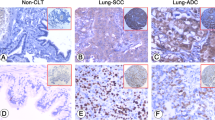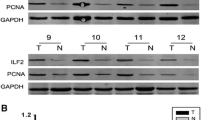Abstract
This study aimed to analyze the expression, clinical significance of proto-oncogene in non small cell lung cancer (NSCLC), and the biological effect in its cell line by siRNA targeting wild-type p53-induced phosphatase 1 (Wip1). Immunohistochemistry and reverse transcription polymerase chain reaction (RT-PCR) were, respectively, used to analyze Wip1 protein expression in 75 cases of NSCLC and normal tissues to study the relationship between Wip1 expression and clinical parameters. Wip1 siRNA was transiently transfected into papillary NSCLC H1299 cell by liposome-mediated method and was detected by RT-PCR and Western blot. MTT assay, cell apoptosis, and cell cycle were also conducted as to the influence of the downregulated expression of Wip1 that might be found on H1299 cells biological effect. The positive rates of Wip1 protein was 69.3 % in NSCLC tissues but 16.0 % expressed in normal tissues (P < 0.05). The relative content of Wip1 mRNA was 0.785 ± 0.062 and 0.147 ± 0.020 in NSCLC tissues and normal tissues, respectively, with significant differences between the two types (P < 0.05). There were no significant differences between Wip1 expression and sex, age, tumor size, and pathological types (P > 0.05). However, there were significant differences between Wip1 expression and lymph node metastasis, clinical stages, and tumor differentiation (P < 0.05). Individuals with positive and negative levels of Wip1 expression showed were statistically significant differences in the 5-year overall survival rate (P < 0.05). RT-PCR and Western blot showed that H1299 cell transfected Wip1 siRNA had a lower relative expressive content than normal cell (P < 0.05). MTT assay, cell apoptosis, and cell cycles demonstrated that H1299 cell transfected Wip1 siRNA had a lower survival fraction, higher cell apoptosis, more percentage of the G0/G1 phases, and lower cells in the S phases (P < 0.05). Wip1 protein and mRNA were increased in NSCLC, specifically in lymph node metastasis, clinical stages, and tumor differentiation. Wip1 may be involved in the biological processes of NSCLC cell proliferation, cell apoptosis, and cell cycle.







Similar content being viewed by others
References
Sculier JP. Non small cell lung cancer. Eur Respir Rev. 2013;22:33–6.
Sculier JP, Berghmans T, Meert AP. Thoracic oncology: annual review. Rev Med Brux. 2013;34:100–11.
Fuku T, Semba S, Yutori H, Yokozaki H. Increased wild-type p53-induced phosphatase 1 (Wip1 or PPM1D) expression correlated with downregulation of checkpoint kinase 2 in human gastric carcinoma. Pathol Int. 2007;57:566–71.
Li J, Yang Y, Peng Y, Austin RJ, van Eyndhoven WG, Nguyen KC, et al. Oncogenic properties of PPM1D located within a breast cancer amplification epicenter at 17q23. Nat Genet. 2002;31:133–4.
Saito-Ohara F, Imoto I, Inoue J, Inoue J, Hosoi H, Nakagawara A, et al. PPM1D is a potential target for 17q gain in neuroblastoma. Cancer Res. 2003;63:1876–83.
Mendrzyk F, Radlwimmer B, Joos S, Kokocinski F, Benner A, Stange DE, et al. Economic and protein expression profiling identifies CDK6 as novel in dependent prognostic marker in medulloblastoma. J Clin Oncol. 2005;23:8853–62.
Yang DH, He JA, Li J, Ma WF, Hu XH, Xin SJ, et al. Expression of proto-oncogene Wip1 in breast cancer and its clinical significance. Natl Med J Chin. 2010;90:519–22.
Ling CH, Jiao BH, Lu SK, Guo EK, Zhang GY. The expression of proto-oncogene Wip1 in human glioblastoma multiforme and cell lines. Chin J Neuro-Oncol. 2011;9:1–6.
Ling CH, Jiao BH, Guo EK, Lu SK. Overexpression of proto-oncogene Wip1 in intracranial ependymomas association with P53. Basic Clin Med. 2011;31:430–4.
Yang DH, Zhang H, Hu XH, Xin SJ, Duan ZQ. Abnormality of p16/p38MAPK/p53/Wip1 pathway in papillary thyroid cancer and its significance. Chin J Gen Surg. 2011;20:1199–202.
Oliva TM, Berthonaud V, Chevalier A, Ducrot C, Marsolier-Kergoat MC, Mann C, et al. The Wip1 phosphatase (PPM1D) antagonizes activation of the Chk2 tumor suppressor kinase. Oncogene. 2007;26:1449–58.
Goldstraw P, Ball D, Jett JR, Le Chevalier T, Lim E, Nicholson AG, et al. Non small cell lung cancer. Lancet. 2011;378:1727–40.
Reck M, Heigener DF, Mok T, Soria JC, Rabe KF. Management of non small cell lung cancer: recent developments. Lancet. 2013;382:709–19.
Tsim S, O'Dowd CA, Milroy R, Davidson S. Staging of non small cell lung cancer (NSCLC): a review. Respir Med. 2010;104:1767–74.
Wang P, Rao J, Yang HF, Zhao HY, Yang L. Inhibitory effects of lentivirus mediated RNA interference targeting human Wip1 gene on the proliferation of human glioma U251 cells. Chin J Exp Surg. 2010;27:76–9.
Baxter EW, Milner J. p53 Regulates LIF expression in human medulloblastoma cells. J Neurooncol. 2010;97:373–82.
Lowe JM, Cha H, Yang Q, Fornace Jr AJ. Nuclear factor-kappaB (NF-kappaB) is a novel positive transcriptional regulator of the oncogenic Wip1 phosphatase. J Biol Chem. 2010;285:5249–57.
Armstrong NJ, Fagotto F, Pthmann C, Rupp RA. Maternal Wnt/β-catenin signaling coactivates transcription through NF-κB binding sites during Xenopus axis formation. PLoS One. 2012;7:e36136.
Pan H, Zhou W, He W, Liu X, Ding Q, Ling L, et al. Genistein inhibits MDA-MB-231 triple-negative breast cancer cell growth by inhibiting NF-kappaB activity via the Notch-1 pathway. Int J Mol Med. 2012;30:337–43.
Conflicts of interest
None
Author information
Authors and Affiliations
Corresponding authors
Additional information
Zhanzhao Fu and Guogui Sun contributed equally to this work.
Rights and permissions
About this article
Cite this article
Fu, Z., Sun, G. & Gu, T. Proto-oncogene Wip1, a member of a new family of proliferative genes in NSCLC and its clinical significance. Tumor Biol. 35, 2975–2981 (2014). https://doi.org/10.1007/s13277-013-1382-y
Received:
Accepted:
Published:
Issue Date:
DOI: https://doi.org/10.1007/s13277-013-1382-y




